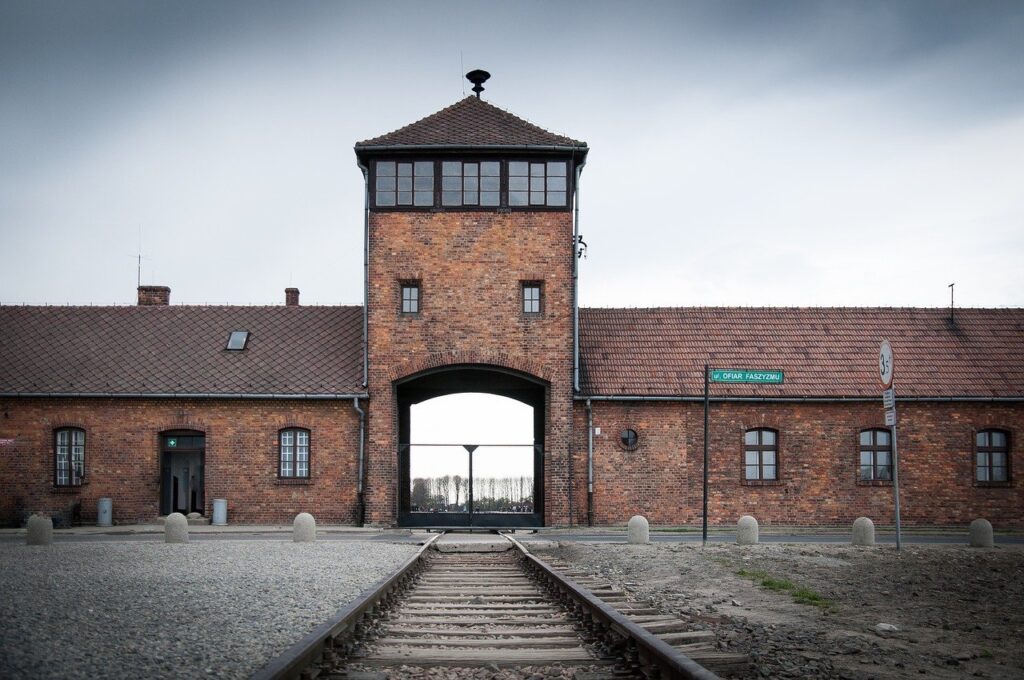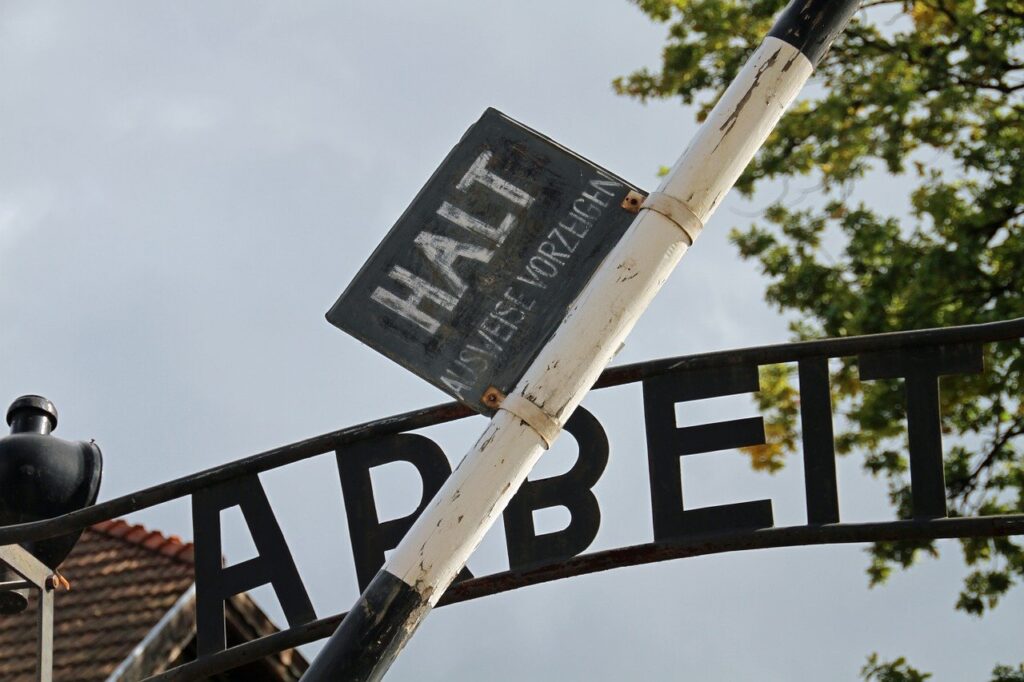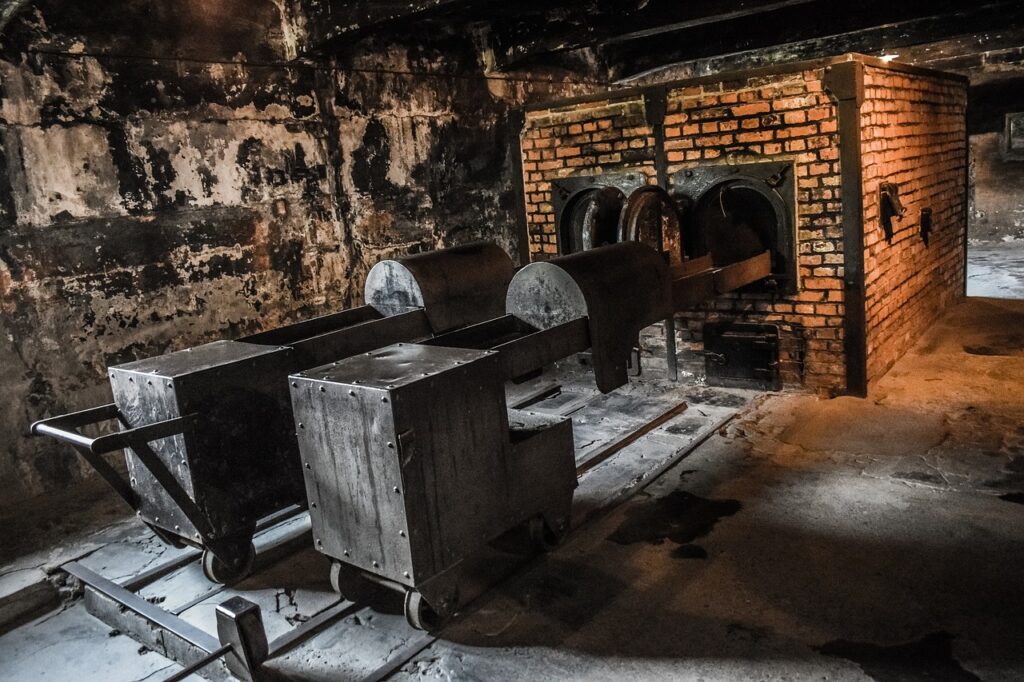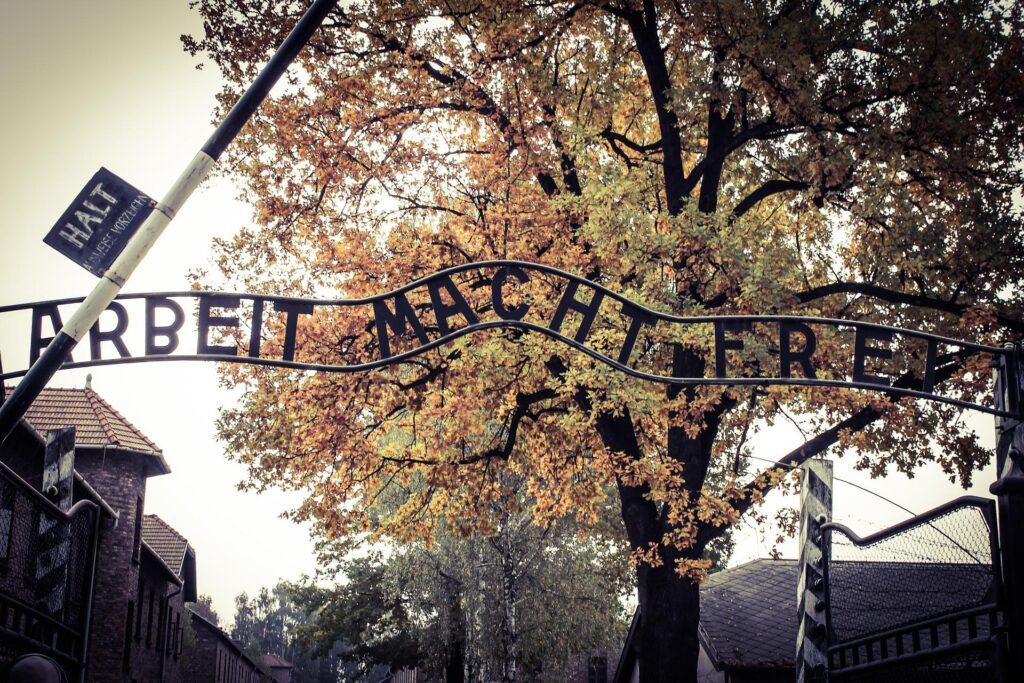
About Auschwitz
Auschwitz concentration camp


What was an Auschwitz concentration camp?
Konzentrationslager (KL) Auschwitz-Birkenau was the largest German Nazi concentration and extermination centers camp. This camp is one of the most famous places to commemorate a tragic history of the Second World War. At least 1.1 million men, women and children of many nationalities died here.
Among them almost one million were Jews, 70-75,000 Poles, 21,000 Roma, 15,000 Soviet POWs, and 10-15,000 of the remaining victims belonged to other nationalities.
The first mass transport to Auschwitz took place on June 14, 1940. Among the prisoners were 728 Polish men who were labeled „political prisoners” and members of the Polish resistance. They were given serial numbers from 31 to 758. Numbers 1 to 30 were given to a group of German criminals who were brought to Auschwitz from Sachsenhausen on May 20.
The first mass transport of Jews to the Auschwitz camp took place in March 1942 from Poprad (Slovakia).

Why was an Auschwitz concentration camp built?
The reason for the establishment of Auschwitz was the increasing number of Poles arrested and the overcrowding of existing prisons. The first transport of Poles arrived at Auschwitz on June 14, 1940 from Tarnów. Originally, Auschwitz was to be another of the concentration camps created by the Nazis. In 1942, Auschwitz became one of the main centers of the „Endlösung der Judenfrage” – the Nazi plan to exterminate Jews living in areas occupied by the Third Reich.
The camp was set up in Oświęcim (which Germans renamed Auschwitz) in the spring of 1940. It was the first concentration camp in occupied Polish territory. For almost two years, the overwhelming majority of the prisoners there were Poles and Polish Jews (in the constantly rising numbers of arriving transports).
The first killing center set up in occupied Polish lands was the camp at Chełmno on the Ner. In December 1941 Germans started killing there Jews brought from the ghettos. Three more camps, somewhat larger, were opened at Bełżec, Sobibor and Treblinka (that was known as “Aktion Reinhard”) between March and July 1942.
In Auschwitz, the murdering of prisoners in gas chambers began even earlier – at the end of June 1941, when 575 sick and disabled prisoners were sent to their deaths at the euthanasia center.
The name Auschwitz aroused fear among the populations of Nazi occupied territories for almost five years. This largest of the Nazi concentration camps was established in 1940 for Polish political prisoners. But as time passed, the Nazis began to deport there people from all over Europe. As the number of inmates increased, so did the area covered by the camp until it was transformed into a gigantic “factory of death”. From 1942 Auschwitz became the biggest center for the mass extermination of mainly Poles, Polish Jews, but also Russians, Roma, Czechs, Yugoslavs, Austrians and Germans. Figures vary but a conservative estimate puts the number of murdered In Auschwitz at an approximate 1,1 million.

Why was an Auschwitz concentration camp built?
The reason for the establishment of Auschwitz was the increasing number of Poles arrested and the overcrowding of existing prisons. The first transport of Poles arrived at Auschwitz on June 14, 1940 from Tarnów. Originally, Auschwitz was to be another of the concentration camps created by the Nazis. In 1942, Auschwitz became one of the main centers of the „Endlösung der Judenfrage” – the Nazi plan to exterminate Jews living in areas occupied by the Third Reich.
The camp was set up in Oświęcim (which Germans renamed Auschwitz) in the spring of 1940. It was the first concentration camp in occupied Polish territory. For almost two years, the overwhelming majority of the prisoners there were Poles and Polish Jews (in the constantly rising numbers of arriving transports).
The first killing center set up in occupied Polish lands was the camp at Chełmno on the Ner. In December 1941 Germans started killing there Jews brought from the ghettos. Three more camps, somewhat larger, were opened at Bełżec, Sobibor and Treblinka (that was known as “Aktion Reinhard”) between March and July 1942.
In Auschwitz, the murdering of prisoners in gas chambers began even earlier – at the end of June 1941, when 575 sick and disabled prisoners were sent to their deaths at the euthanasia center.
The name Auschwitz aroused fear among the populations of Nazi occupied territories for almost five years. This largest of the Nazi concentration camps was established in 1940 for Polish political prisoners. But as time passed, the Nazis began to deport there people from all over Europe. As the number of inmates increased, so did the area covered by the camp until it was transformed into a gigantic “factory of death”. From 1942 Auschwitz became the biggest center for the mass extermination of mainly Poles, Polish Jews, but also Russians, Roma, Czechs, Yugoslavs, Austrians and Germans. Figures vary but a conservative estimate puts the number of murdered In Auschwitz at an approximate 1,1 million.
Auschwitz Camp parts
Due to its growing size, in 1943 Auschwitz was divided into three camps with different functions:

Auschwitz I
Auschwitz I was the main camp at Auschwitz. This is where the administration, the office of the commandant of Auschwitz I, the supply stores, workshops and SS companies had their place. Work in these places was the main form of employment for the prisoners of this camp.
The first gassing In Auschwitz took place in early September 1941. Around 850 inmates were killed with Zyklon B in the basement of block 11 in Auschwitz I. The victims were Soviet prisoners of war and sick Polish inmates. To keep the victims calm, they were told they were to undergo disinfection and de-lousing. The unsuspecting prisoners would undress before they would be led to the gas chamber. After its decommissioning, the building was converted to a storage facility and later, an SS air-raid shelter. The gas chamber and crematorium were reconstructed after the war.
Auschwitz II-Birkenau
The Birkenau camp was the largest of the more than 40 camps and sub-camps in the Auschwitz camp complex. Built in March 1942 as a camp for around 125,000 prisoners of war, it was a branch of Auschwitz Concentration Camp and at the same time served as a centre for the extermination of Jews. From 1944, it also became a place for the concentration of prisoners before they were transferred to work for German industry deep inside the Third Reich. About 90% of the victims of Auschwitz, or about 1 million people, died at Birkenau: the vast majority (over 90%) were Jews. In addition, a significant proportion of the approximately 70,000 Poles who died and were killed in the Auschwitz camp complex, about 20,000 Gypsies, in addition to Soviet prisoners of war and prisoners of other nationalities, died in this camp.
Auschwitz III-Monowitz
The Monowice camp was one of the first and also the largest Auschwitz sub-camps. Over time, it acquired the status of the headquarters of the „industrial” sub-camps, and its commandant concentrated in his hands both managerial, administrative and command functions with respect to the SS crews subordinate to him.
Auschwitz Museum


The decision to create the Auschwitz Museum was made as early as April 1946, when the Ministry of Culture and the Arts sent a group of former prisoners to Oswiecim to protect the grounds of the former Auschwitz camp and create a museum there.
The Museum was to be a „historical document.” The plan was that it would present the annihilation of the nations conquered by the Germans, exposing the mass nature of German crimes, avoiding the „macabre” and using only appropriate artistic solutions.
The exhibition was to include three parts: a general one showing the fate of prisoners in the camp, an international one devoted to the wartime situation of nations whose representatives were deported to Auschwitz, and a part illustrating the history of other German concentration camps.
The museum was officially opened on June 14, 1947.
The Auschwitz Museum is the only concentration camp on the UNESCO World Heritage list. Since 1947 Auschwitz is open for visiting as the Auschwitz-Birkenau Memorial and Museum.
The grounds of the Auschwitz site could be visited as early as 1945. However, tours were limited to organized groups or took place on the occasion of various ceremonies. Only after organizational work began was it possible to visit the Auschwitz site on a general basis, and in 1946 the number of visitors reached 100,000. A year later, Auschwitz had already been visited by 170,000 people.
Each year millions of visitors visit Auschwitz Museum. In 2019, over 2.3 million people visited Auschwitz and year after year this attendance continues to grow.
The Auschwitz Concentration Camp is a reminder of the atrocities inflicted on millions of people and has become a symbol of what man can do worst to other human beings…
Auschwitz-Birkenau timeline

1939
- September 1: Nazi Germany’s invasion of Poland begins World War II in Europe. The Nazis massacre Polish Jews or force them into ghettos, begin to displace Polish elites and try to stop resistance.
1940
- April 27: Schutzstaffel (SS) commander Heinrich Himmler selects a site for barracks at Oświęcim in southern Poland, which is renamed Auschwitz.
- June 14: Arrival of first 728 Polish political prisoners.
- Autumn: The resistance movement informs the Polish government in exile in London about the Auschwitz camp, which in turn informs the Allies.
1941
- March 1: Himmler inspects Auschwitz, orders expansion.
- June 22: Germany invades the Soviet Union, breaking the 1939 pact, sends prisoners of war to the Auschwitz camp.
- September 3: First mass gassing in Auschwitz with Zyklon B of 600 Soviet POWs and 250 Poles.
1942
- January 20: Nazis set plans for „Final Solution,” genocide of European Jews.
- January: Mass gassing of Jews at Auschwitz begins.
- March 1: Auschwitz II-Birkenau camp opens.
- March: First mass deportation of foreign Jews to the Auschwitz camp, 69,000 from France, 27,000 from Slovakia.
- May: 300,000 Jews sent from Poland, 23,000 from Germany and Austria.
- May 4: Birkenau’s first „selection” of incoming prisoners, separating those who were destined for captivity from those who were to be gassed.
- June 10: Revolt at Birkenau – seven prisoners escape from Auschwitz camp, 300 are killed.
- July: 60,000 Jews shipped to Auschwitz camp from the Netherlands.
- August: 25,000 Jews from Belgium, 10,000 from Yugoslavia.
- October 30: industrial camp „Auschwitz III-Monowitz” opened.
- October: 46,000 Jews sent from present-day Czech Republic.
- December: 700 Jews sent from Norway.
1943
- February 26: A camp for Roma is established in Birkenau.
- March: 55,000 Jews sent from Greece.
- October: 7,500 Jews sent from Italy.
1944
- May: Allied planes photograph the camp, spot gas chambers and smoke. Britain and the United States later bomb Monowitz.
- May: 438,000 Jews sent from Hungary.
- August: 67,000 Jews sent from the Lodz ghetto in Poland.
- August 2: 3,000 Roma are gassed.
- August: 13,000 Poles sent among the Warsaw Uprising.
- October 7: Revolt of „Sonderkommando,” Jews forced to burn bodies from gas chambers. Three SS men are killed, 450 Sonderkommando prisoners.
- November: Mass gassing ends.
1945
- January 17: „Death March” – SS forces 60,000 prisoners to flee west while Soviets advance.
- January 21-26: Germans blow up gas chambers and crematoria at Birkenau, retreat as Soviet scouts approach.
- January 27: Soviet troops arrive and find 7,000 survivors.
Information for Visitors

Auschwitz-Birkenau opening hours
- January & November: 8:00 AM – 3:00 PM
- February: 8:00 AM – 4:00 PM
- March, October: 8:00 AM – 5:00 PM
- April, May & September: 8:00 AM – 6:00 PM
- June, July & August: 8:00 AM – 7:00 PM
- December: 8:00 AM – 2:00 PM
Auschwitz Museum is closed only 3 days a year: on January 1, December 25, and Easter Sunday.
Useful information
- Since you would be walking a lot on different paths in Auschwitz, please wear comfortable shoes and clothes depending on the weather forecast
- Visitors are provided with access to the grounds and facilities of the former camps of Auschwitz I and Auschwitz II-Birkenau. The duration of the visit depends on the individual interests and needs of visitors, but as a minimum you should spend about 3-4 hours getting acquainted with the grounds and exhibition at the former Auschwitz camp, but depending on the volume of traffic the visiting time may be longer
- While on the grounds of the Auschwitz Memorial you should behave with due solemnity and respect for the place
- The maximum size of backpacks or bags you can get into the Auschwitz Museum is 30x20x10 cm
Visitors can leave their luggage in a paid luggage locker - You can photograph the Auschwitz Memorial for private purposes but pay attention to the “No Photography” and don’t use flash
- We do not recommend that children under 14 years of age visit the Auschwitz Museum
- You may need change (2 PLN) to use the toilets inside the Auschwitz Museum
Visiting Auschwitz-Birkenau
In order to become properly acquainted with the place that has become a symbol of the Holocaust and the Nazi crimes committed against Poles, Roma and others, it is necessary to visit both parts of the former camp – both Auschwitz I and Auschwitz II-Birkenau.
Open to visitors are the grounds and most of the buildings of the former camps Auschwitz I and Auschwitz-II Birkenau.
In Auschwitz I, the Nazis established the first camp for men and women, it was here that the first killing experiments with Zyklon B took place, it was here that they murdered the first mass transports of Jews, it was here that they conducted the first criminal experiments on prisoners, it was here that they carried out the majority of executions by shooting, and it was here that the central camp jail was located in block 11 for prisoners from all parts of the camp complex, as well as the main camp commandant’s office and most of the SS offices. From here the camp authorities directed the further expansion of the camp complex.
In the Birkenau camp, the Nazis built most of the mass extermination facilities where approximately one million Jews were murdered. Birkenau was at the same time the largest concentration camp (nearly 300 primitive, mostly wooden barracks), with over 100,000 prisoners in 1944: Jews, Poles, Roma, and others. The ruins of gas chambers and places filled with human ashes, primitive prisoner barracks and kilometres of camp fences and roads have been preserved on nearly 200 ha.
Frequently Answered Questions (FAQ) about visiting Auschwitz
-
Q. Is visiting Auschwitz recommended for children?
A. It is not recommended that children under the age of 14 visit the museum. -
Q: Do I need to have an entrance card to visit Auschwitz?
A: Entrance to the Museum, both to the former Auschwitz I camp and Birkenau, is possible only with a pre-booked personal admission card. -
Q. Can you go to Auschwitz with a guide?
A. Yes, you can take guided Auschwitz tours to learn more about its tragic history. -
Q. Do I have to bring any ID with me when I enter the Auschwitz Museum?
A. Yes, to enter the Auschwitz Museum, you need any valid ID with a clear photograph of the visitor to enter. -
Q. What are the current covid-19 restrictions?
A: Due to Covid-19, safety rules under sanitary regulations apply, so there is, among other things, a reduced number of people who can visit the Auschwitz Museum at the same time and the frequency of visits -
Q. How much does the Auschwitz tours cost?
A. The Skip-the-Line Ticket and Guided Tour starts from €29. -
Q. What is the best way to buy tickets to visit Auschwitz?
A: The best way to buy tickets to Auschwitz Museum is to order them at www.tourstoauschwitz.com along with transportation to and from Krakow. -
Q. Can I buy Auschwitz tours online?
A. Yes, the tickets to Auschwitz tours can be bought online at www.tourstoauschwitz.com. -
Q. Can I cancel the Auschwitz tours tickets?
visitors can get a full refund on their ticket if they cancel 48 hours or 24 hours prior to the tour.A. Yes, the tickets to Auschwitz tours can be cancelled and -
Q. Do I need to print my tickets to the Auschwitz tour?
A. No, you do not need to print the tickets for the Auschwitz tour. You can download it on your mobile to get the unique barcode of the ticket that will be scanned at the entry. -
Q. How long does the Auschwitz tour take?
A. An Auschwitz tour can last anywhere between 3,5 hours (Auschwitz I) to 5 hours (Auschwitz I + Auschwitz II – Birkenau). -
Q. What is the best time to visit the Auschwitz Museum?
The best time to go for the Auschwitz tours is on the weekdays. There are fewer tourists present then.
Follow us on:
Find more information at:
Krakow Travel
Oskar Schindler’s Enamel Factory
Kazimierz – the “Jewish city”
Wawel Royal Castle